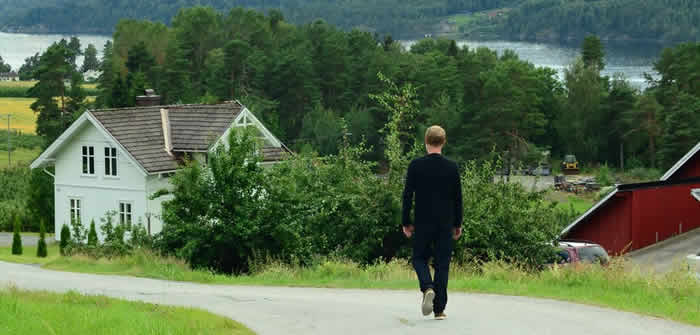very now and then, I like to highlight noteworthy films that aren’t, or are hardly, available to the public, both because they should be and because their unavailability, due to the vagaries of the marketplace and the milieu, is a kind of news in itself. So it is with a new film, “Gavagai,” by a sharply original and deeply accomplished filmmaker, Rob Tregenza, which screened in July, at the Maine International Film Festival, in Waterville, Maine; it will be playing this weekend at the local art-house theatre, the Reel Pizza Cinerama, in Bar Harbor, Maine; and it won’t, as of now, be playing at other theatres near you. More’s the loss because the film is more than a curiosity; it’s an astonishment, realized with a technique and a touch that are unique in the current cinema.
Though Tregenza is American, the film, which he co-wrote with Kirk Kjeldsen, was made in Norway; it has very little dialogue, most of which is in English. (The title is borrowed from a section of the philosopher W. V. O. Quine’s book “Word and Object,” from 1960, and refers to the attempt to make sense of a word in a foreign language.) The protagonist, whose name is never heard, is played by the Austrian actor Andreas Lust. He arrives in a Norwegian village in the Telemark region and is unsure whether even to stay (the movie’s opening scene is a bittersweet ballet for man and train). But stay he does, and he heads to the office of a local man (Mikkel Gaup), a small-businessperson who leads “elk safari” tours in the wilderness. (Their common language is English.) What the visitor wants from the guide isn’t a safari but simply a ride, and he pays the guide hundreds of dollars to drive him, in an S.U.V., to a remote hillock. That mission accomplished, the visitor then pays the guide for another ride—a longer trip, involving a ferry ride and a stay at an inn, where the purpose of the traveller’s journey is ultimately disclosed: he is bearing an urn with the ashes of his late wife, which he is planning to scatter at a place that’s significant to her.
Between journeys, the guide—whom the traveller has found sleeping on a couch in his safari-office—attempts to rekindle a relationship with a woman named Mari (Anni-Kristiina Juuso), whom he had been keeping at a distance with mealy-mouthed excuses that he comes to regret. “Gavagai” is a drama of two couples, of two stories of shared purpose and forged intimacy—and of love and loss. The traveller and his late wife (who, he says, was Chinese) are writers; their shared project was the translation into Chinese of the work of the real-life Norwegian poet Tarjei Vesaas (1897–1970); and the ultimate destination of the trip is Vesaas’s home town of Vinje, where he lived most of his life. There’s a touch of the metaphysical, as well—visitations of the protagonist’s late wife that are perched on the uncertain border of fantasies, dreams, and hallucinations. With the growing bond between the two men on the road, these visions—evoking both the shared experience of romance and the alienating strangeness of cultural crossings—prove contagious as well.
Tregenza, who was born in 1950, has made only four features, of which I’ve seen only the first, “Talking to Strangers,” from 1996, and the new one. (I wrote about “Talking to Strangers” a few years ago, on the occasion of one of its rare New York screenings.) They share a method—Tregenza, working as his own cinematographer, constructs his scenes from meticulously composed and choreographed long takes. The bravura of his intricate cinematography never feels precious or false. The actors move with a firm tread and an earthbound grace, and they don’t so much pass through the landscape as they are inhabited by it. A scene of the two men on a ferry, doing little more than waiting, has the intimacy of a shared revelation. A scene of an outdoor marriage proposal is all the more transcendent for its terrain-specific bluntness. The scenes of travel in the guide’s van—and its views of the countryside through the windshield—give rise to a rough solidarity that’s dramatized in a deft, simple flourish. The protagonist’s conclusive act of devotion has a rare, symphonic exaltation; a theatrical decrescendo that reunites the characters with a strain of bluff comedy raises the stuff of daily life to luminous glory.
In short, “Gavagai” is an extraordinary and memorable film; its strong and clear emotional refinement arises from a rare force of imagination, a rare power of observation, a rare cinematic sense to fuse them, and a rare skill to realize them together. And it’s dismaying to learn (as I did in an e-mail from Tregenza, whom I’ve never met but did interview, by phone, about fifteen years ago) that the film was rejected by most of the film festivals—including Berlin, Cannes, Venice, Toronto, and London—to which it was submitted. I’ve seen some films that played at these festivals and that I consider vastly inferior to “Gavagai,” which had its world première last year at the Norwegian Film Institute Cinemateket in Oslo. (Tregenza told me that the only American festival to which he had submitted it was the Maine International, where it had its U. S. première.)
I consider myself fortunate to have been invited to see “Gavagai,” and I hope that other viewers beyond those near Bar Harbor this weekend will get to see it, too. Along with the particular and enduring pleasures of the film itself, the viewing raises another, troubling set of questions: Which other great or near-great—in any case, beautiful and moving—films are being made off the festival and industry radar and are hardly being seen?
Written by Richard Brody for The New Yorker

